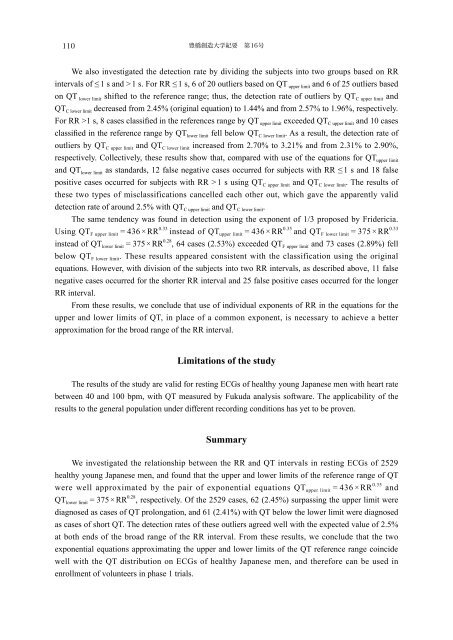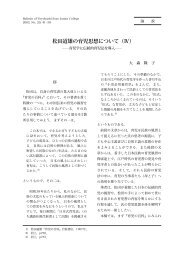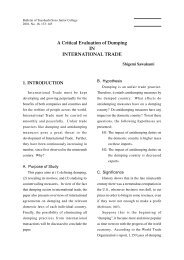The upper and lower limits of the reference range of the QT interval ...
The upper and lower limits of the reference range of the QT interval ...
The upper and lower limits of the reference range of the QT interval ...
You also want an ePaper? Increase the reach of your titles
YUMPU automatically turns print PDFs into web optimized ePapers that Google loves.
110 豊 橋 創 造 大 学 紀 要 第 16 号<br />
We also investigated <strong>the</strong> detection rate by dividing <strong>the</strong> subjects into two groups based on RR<br />
<strong>interval</strong>s <strong>of</strong> ≤ 1 s <strong>and</strong> > 1 s. For RR ≤ 1 s, 6 <strong>of</strong> 20 outliers based on <strong>QT</strong> <strong>upper</strong> limit <strong>and</strong> 6 <strong>of</strong> 25 outliers based<br />
on <strong>QT</strong> <strong>lower</strong> limit shifted to <strong>the</strong> <strong>reference</strong> <strong>range</strong>; thus, <strong>the</strong> detection rate <strong>of</strong> outliers by <strong>QT</strong> C <strong>upper</strong> limit <strong>and</strong><br />
<strong>QT</strong> C <strong>lower</strong> limit decreased from 2.45% (original equation) to 1.44% <strong>and</strong> from 2.57% to 1.96%, respectively.<br />
For RR >1 s, 8 cases classified in <strong>the</strong> <strong>reference</strong>s <strong>range</strong> by <strong>QT</strong> <strong>upper</strong> limit exceeded <strong>QT</strong> C <strong>upper</strong> limit <strong>and</strong> 10 cases<br />
classified in <strong>the</strong> <strong>reference</strong> <strong>range</strong> by <strong>QT</strong> <strong>lower</strong> limit fell below <strong>QT</strong> C <strong>lower</strong> limit . As a result, <strong>the</strong> detection rate <strong>of</strong><br />
outliers by <strong>QT</strong> C <strong>upper</strong> limit <strong>and</strong> <strong>QT</strong> C <strong>lower</strong> limit increased from 2.70% to 3.21% <strong>and</strong> from 2.31% to 2.90%,<br />
respectively. Collectively, <strong>the</strong>se results show that, compared with use <strong>of</strong> <strong>the</strong> equations for <strong>QT</strong> <strong>upper</strong> limit<br />
<strong>and</strong> <strong>QT</strong> <strong>lower</strong> limit as st<strong>and</strong>ards, 12 false negative cases occurred for subjects with RR ≤ 1 s <strong>and</strong> 18 false<br />
positive cases occurred for subjects with RR > 1 s using <strong>QT</strong> C <strong>upper</strong> limit <strong>and</strong> <strong>QT</strong> C <strong>lower</strong> limit . <strong>The</strong> results <strong>of</strong><br />
<strong>the</strong>se two types <strong>of</strong> misclassifications cancelled each o<strong>the</strong>r out, which gave <strong>the</strong> apparently valid<br />
detection rate <strong>of</strong> around 2.5% with <strong>QT</strong> C <strong>upper</strong> limit <strong>and</strong> <strong>QT</strong> C <strong>lower</strong> limit .<br />
<strong>The</strong> same tendency was found in detection using <strong>the</strong> exponent <strong>of</strong> 1/3 proposed by Fridericia.<br />
Using <strong>QT</strong> F <strong>upper</strong> limit = 436×RR 0.33 instead <strong>of</strong> <strong>QT</strong> <strong>upper</strong> limit = 436 ×RR 0.35 <strong>and</strong> <strong>QT</strong> F <strong>lower</strong> limit = 375 ×RR 0.33<br />
instead <strong>of</strong> <strong>QT</strong> <strong>lower</strong> limit = 375×RR 0.28 , 64 cases (2.53%) exceeded <strong>QT</strong> F <strong>upper</strong> limit <strong>and</strong> 73 cases (2.89%) fell<br />
below <strong>QT</strong> F <strong>lower</strong> limit . <strong>The</strong>se results appeared consistent with <strong>the</strong> classification using <strong>the</strong> original<br />
equations. However, with division <strong>of</strong> <strong>the</strong> subjects into two RR <strong>interval</strong>s, as described above, 11 false<br />
negative cases occurred for <strong>the</strong> shorter RR <strong>interval</strong> <strong>and</strong> 25 false positive cases occurred for <strong>the</strong> longer<br />
RR <strong>interval</strong>.<br />
From <strong>the</strong>se results, we conclude that use <strong>of</strong> individual exponents <strong>of</strong> RR in <strong>the</strong> equations for <strong>the</strong><br />
<strong>upper</strong> <strong>and</strong> <strong>lower</strong> <strong>limits</strong> <strong>of</strong> <strong>QT</strong>, in place <strong>of</strong> a common exponent, is necessary to achieve a better<br />
approximation for <strong>the</strong> broad <strong>range</strong> <strong>of</strong> <strong>the</strong> RR <strong>interval</strong>.<br />
Limitations <strong>of</strong> <strong>the</strong> study<br />
<strong>The</strong> results <strong>of</strong> <strong>the</strong> study are valid for resting ECGs <strong>of</strong> healthy young Japanese men with heart rate<br />
between 40 <strong>and</strong> 100 bpm, with <strong>QT</strong> measured by Fukuda analysis s<strong>of</strong>tware. <strong>The</strong> applicability <strong>of</strong> <strong>the</strong><br />
results to <strong>the</strong> general population under different recording conditions has yet to be proven.<br />
Summary<br />
We investigated <strong>the</strong> relationship between <strong>the</strong> RR <strong>and</strong> <strong>QT</strong> <strong>interval</strong>s in resting ECGs <strong>of</strong> 2529<br />
healthy young Japanese men, <strong>and</strong> found that <strong>the</strong> <strong>upper</strong> <strong>and</strong> <strong>lower</strong> <strong>limits</strong> <strong>of</strong> <strong>the</strong> <strong>reference</strong> <strong>range</strong> <strong>of</strong> <strong>QT</strong><br />
were well approximated by <strong>the</strong> pair <strong>of</strong> exponential equations <strong>QT</strong> <strong>upper</strong> limit = 436×RR 0.35 <strong>and</strong><br />
<strong>QT</strong> <strong>lower</strong> limit = 375×RR 0.28 , respectively. Of <strong>the</strong> 2529 cases, 62 (2.45%) surpassing <strong>the</strong> <strong>upper</strong> limit were<br />
diagnosed as cases <strong>of</strong> <strong>QT</strong> prolongation, <strong>and</strong> 61 (2.41%) with <strong>QT</strong> below <strong>the</strong> <strong>lower</strong> limit were diagnosed<br />
as cases <strong>of</strong> short <strong>QT</strong>. <strong>The</strong> detection rates <strong>of</strong> <strong>the</strong>se outliers agreed well with <strong>the</strong> expected value <strong>of</strong> 2.5%<br />
at both ends <strong>of</strong> <strong>the</strong> broad <strong>range</strong> <strong>of</strong> <strong>the</strong> RR <strong>interval</strong>. From <strong>the</strong>se results, we conclude that <strong>the</strong> two<br />
exponential equations approximating <strong>the</strong> <strong>upper</strong> <strong>and</strong> <strong>lower</strong> <strong>limits</strong> <strong>of</strong> <strong>the</strong> <strong>QT</strong> <strong>reference</strong> <strong>range</strong> coincide<br />
well with <strong>the</strong> <strong>QT</strong> distribution on ECGs <strong>of</strong> healthy Japanese men, <strong>and</strong> <strong>the</strong>refore can be used in<br />
enrollment <strong>of</strong> volunteers in phase 1 trials.




